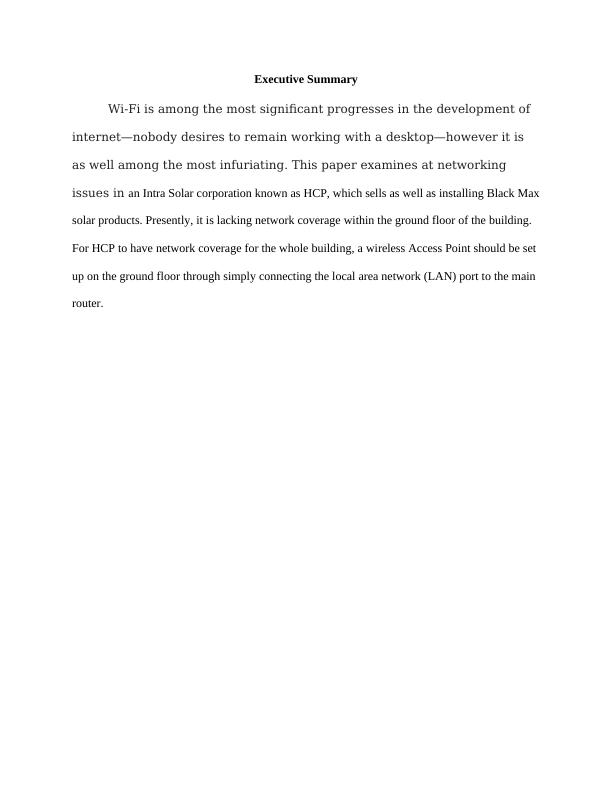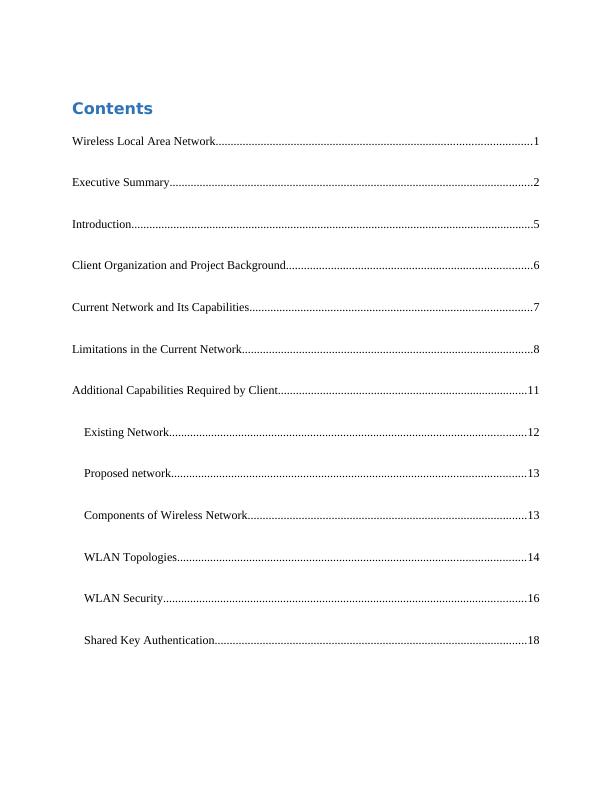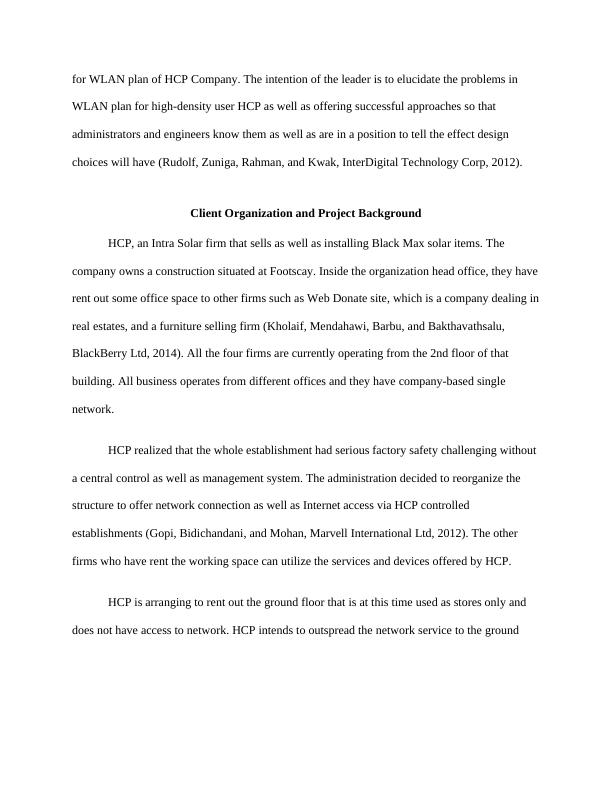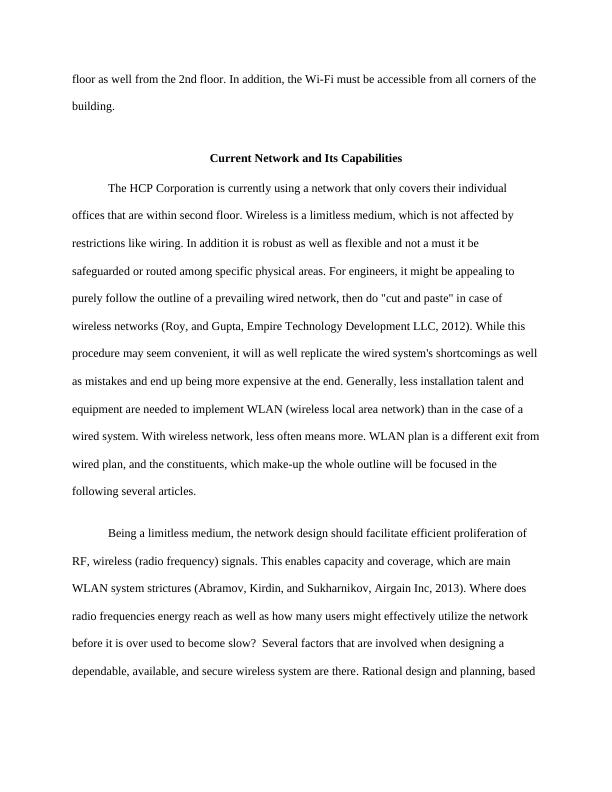Wireless Local Area Network: Design and Implementation for HCP Corporation
Design a wireless network for a Small to Medium Enterprise (SME) based on their requirements and limitations, including additional capabilities and network design solutions.
38 Pages7186 Words353 Views
Added on 2023-06-11
About This Document
This paper examines the networking issues faced by HCP Corporation and proposes the implementation of a wireless local area network to provide network coverage for the whole building. It discusses the current network limitations, additional capabilities required, and proposed network components, including WLAN topologies and security measures.
Wireless Local Area Network: Design and Implementation for HCP Corporation
Design a wireless network for a Small to Medium Enterprise (SME) based on their requirements and limitations, including additional capabilities and network design solutions.
Added on 2023-06-11
ShareRelated Documents
Wireless Local Area Network
Name
Institution
Date
Name
Institution
Date

Executive Summary
Wi-Fi is among the most significant progresses in the development of
internet—nobody desires to remain working with a desktop—however it is
as well among the most infuriating. This paper examines at networking
issues in an Intra Solar corporation known as HCP, which sells as well as installing Black Max
solar products. Presently, it is lacking network coverage within the ground floor of the building.
For HCP to have network coverage for the whole building, a wireless Access Point should be set
up on the ground floor through simply connecting the local area network (LAN) port to the main
router.
Wi-Fi is among the most significant progresses in the development of
internet—nobody desires to remain working with a desktop—however it is
as well among the most infuriating. This paper examines at networking
issues in an Intra Solar corporation known as HCP, which sells as well as installing Black Max
solar products. Presently, it is lacking network coverage within the ground floor of the building.
For HCP to have network coverage for the whole building, a wireless Access Point should be set
up on the ground floor through simply connecting the local area network (LAN) port to the main
router.

Contents
Wireless Local Area Network.........................................................................................................1
Executive Summary.........................................................................................................................2
Introduction......................................................................................................................................5
Client Organization and Project Background..................................................................................6
Current Network and Its Capabilities..............................................................................................7
Limitations in the Current Network.................................................................................................8
Additional Capabilities Required by Client...................................................................................11
Existing Network.......................................................................................................................12
Proposed network......................................................................................................................13
Components of Wireless Network.............................................................................................13
WLAN Topologies....................................................................................................................14
WLAN Security.........................................................................................................................16
Shared Key Authentication........................................................................................................18
Wireless Local Area Network.........................................................................................................1
Executive Summary.........................................................................................................................2
Introduction......................................................................................................................................5
Client Organization and Project Background..................................................................................6
Current Network and Its Capabilities..............................................................................................7
Limitations in the Current Network.................................................................................................8
Additional Capabilities Required by Client...................................................................................11
Existing Network.......................................................................................................................12
Proposed network......................................................................................................................13
Components of Wireless Network.............................................................................................13
WLAN Topologies....................................................................................................................14
WLAN Security.........................................................................................................................16
Shared Key Authentication........................................................................................................18

Selection of Suitable Software and Hardware...........................................................................20
Implementation..........................................................................................................................20
Setup..........................................................................................................................................26
Guideline and Policy for Wireless Network Use.......................................................................30
Policy Scope..........................................................................................................................30
Policy Restriction...................................................................................................................30
Appropriate and Proper use...................................................................................................31
Regulatory Measures.............................................................................................................31
Acceptance of Policies and Regulations................................................................................32
Conclusion.....................................................................................................................................32
Implementation..........................................................................................................................20
Setup..........................................................................................................................................26
Guideline and Policy for Wireless Network Use.......................................................................30
Policy Scope..........................................................................................................................30
Policy Restriction...................................................................................................................30
Appropriate and Proper use...................................................................................................31
Regulatory Measures.............................................................................................................31
Acceptance of Policies and Regulations................................................................................32
Conclusion.....................................................................................................................................32

Introduction
Being familiar with 802.11 radio indicators broadcasting from an aerial in horizontal
directions to the first floor of the building. When installing wireless networks in multi-floor
facilities, however, one should put into consideration that waves also propagate down and up
vertically to the floors (Kim, Jeon, Park, and Youn, Samsung Electronics Co Ltd, 2013). The
extent is not far in the case of vertical direction, nevertheless it is frequently enough to enter the
ceilings and floors in most constructions. The inter-floor signal transmission makes surveying of
sites become more complex, however one might be in a position to exploit the situation.
The first step is gaining a good know how of the way 802.11 signals circulate thru
different floors within the building where wireless network is to be deployed. Every facility is
different from the other, therefore it is advisable to do a bit of testing to decide the number of
floors that actually can attenuate the radio signals. It is important to remember that 5GHz and
2.4GHz signals proliferate differently via the same medium, therefore testing must be performed
Being familiar with 802.11 radio indicators broadcasting from an aerial in horizontal
directions to the first floor of the building. When installing wireless networks in multi-floor
facilities, however, one should put into consideration that waves also propagate down and up
vertically to the floors (Kim, Jeon, Park, and Youn, Samsung Electronics Co Ltd, 2013). The
extent is not far in the case of vertical direction, nevertheless it is frequently enough to enter the
ceilings and floors in most constructions. The inter-floor signal transmission makes surveying of
sites become more complex, however one might be in a position to exploit the situation.
The first step is gaining a good know how of the way 802.11 signals circulate thru
different floors within the building where wireless network is to be deployed. Every facility is
different from the other, therefore it is advisable to do a bit of testing to decide the number of
floors that actually can attenuate the radio signals. It is important to remember that 5GHz and
2.4GHz signals proliferate differently via the same medium, therefore testing must be performed

using the frequency one is planning to install. When installing 802.11n, it is advisable to test
both 5GHz and 2.4GHz frequencies (Ibrahim, Brancato, and Bongiorno, Apple Inc, 2017). Do
the test at the start of RF site surveys in order to get an enhanced idea of the way to position
testing access point based on inter-floor signals propagation.
Despite the fact that, great advances have been made in terms of the ease and speed of
implementing Wi-Fi network, the simple nature of RF (radio frequency) is generally unaffected.
Increasing the users accessing the WLAN within a small physical area remains a problem
(Sorrells, Bultman, Cook, Looke, Moses Jr, Rawlins, and Rawlins, ParkerVision Inc, 2012). The
process and steps for an effective high user densities WLAN design, which can be verified,
implemented, as well as maintained through Cisco’s Unified Wireless Network design is defined.
It includes the following general stages:
Plan: Decide application as well as device required such as protocols, bandwidth, frequencies,
SLA (service level agreement), etc.
Design: Control density, antennas, cell sizing, site survey, coverage, etc.
Implement: Installation, tune, establish baseline, test, etc.
Optimize: Monitor, adjust, report, reviewing baseline for service level agreement (SLA).
Operate: Cisco WCS (Wireless Control System) checking, troubleshooting apparatuses,
reporting and capacity monitoring tools, etc.
The general ideas in the high-density Wi-Fi plan remain factual for several environments.
However it is significant to remember that the solutions and content offered will be appropriate
both 5GHz and 2.4GHz frequencies (Ibrahim, Brancato, and Bongiorno, Apple Inc, 2017). Do
the test at the start of RF site surveys in order to get an enhanced idea of the way to position
testing access point based on inter-floor signals propagation.
Despite the fact that, great advances have been made in terms of the ease and speed of
implementing Wi-Fi network, the simple nature of RF (radio frequency) is generally unaffected.
Increasing the users accessing the WLAN within a small physical area remains a problem
(Sorrells, Bultman, Cook, Looke, Moses Jr, Rawlins, and Rawlins, ParkerVision Inc, 2012). The
process and steps for an effective high user densities WLAN design, which can be verified,
implemented, as well as maintained through Cisco’s Unified Wireless Network design is defined.
It includes the following general stages:
Plan: Decide application as well as device required such as protocols, bandwidth, frequencies,
SLA (service level agreement), etc.
Design: Control density, antennas, cell sizing, site survey, coverage, etc.
Implement: Installation, tune, establish baseline, test, etc.
Optimize: Monitor, adjust, report, reviewing baseline for service level agreement (SLA).
Operate: Cisco WCS (Wireless Control System) checking, troubleshooting apparatuses,
reporting and capacity monitoring tools, etc.
The general ideas in the high-density Wi-Fi plan remain factual for several environments.
However it is significant to remember that the solutions and content offered will be appropriate

for WLAN plan of HCP Company. The intention of the leader is to elucidate the problems in
WLAN plan for high-density user HCP as well as offering successful approaches so that
administrators and engineers know them as well as are in a position to tell the effect design
choices will have (Rudolf, Zuniga, Rahman, and Kwak, InterDigital Technology Corp, 2012).
Client Organization and Project Background
HCP, an Intra Solar firm that sells as well as installing Black Max solar items. The
company owns a construction situated at Footscay. Inside the organization head office, they have
rent out some office space to other firms such as Web Donate site, which is a company dealing in
real estates, and a furniture selling firm (Kholaif, Mendahawi, Barbu, and Bakthavathsalu,
BlackBerry Ltd, 2014). All the four firms are currently operating from the 2nd floor of that
building. All business operates from different offices and they have company-based single
network.
HCP realized that the whole establishment had serious factory safety challenging without
a central control as well as management system. The administration decided to reorganize the
structure to offer network connection as well as Internet access via HCP controlled
establishments (Gopi, Bidichandani, and Mohan, Marvell International Ltd, 2012). The other
firms who have rent the working space can utilize the services and devices offered by HCP.
HCP is arranging to rent out the ground floor that is at this time used as stores only and
does not have access to network. HCP intends to outspread the network service to the ground
WLAN plan for high-density user HCP as well as offering successful approaches so that
administrators and engineers know them as well as are in a position to tell the effect design
choices will have (Rudolf, Zuniga, Rahman, and Kwak, InterDigital Technology Corp, 2012).
Client Organization and Project Background
HCP, an Intra Solar firm that sells as well as installing Black Max solar items. The
company owns a construction situated at Footscay. Inside the organization head office, they have
rent out some office space to other firms such as Web Donate site, which is a company dealing in
real estates, and a furniture selling firm (Kholaif, Mendahawi, Barbu, and Bakthavathsalu,
BlackBerry Ltd, 2014). All the four firms are currently operating from the 2nd floor of that
building. All business operates from different offices and they have company-based single
network.
HCP realized that the whole establishment had serious factory safety challenging without
a central control as well as management system. The administration decided to reorganize the
structure to offer network connection as well as Internet access via HCP controlled
establishments (Gopi, Bidichandani, and Mohan, Marvell International Ltd, 2012). The other
firms who have rent the working space can utilize the services and devices offered by HCP.
HCP is arranging to rent out the ground floor that is at this time used as stores only and
does not have access to network. HCP intends to outspread the network service to the ground

floor as well from the 2nd floor. In addition, the Wi-Fi must be accessible from all corners of the
building.
Current Network and Its Capabilities
The HCP Corporation is currently using a network that only covers their individual
offices that are within second floor. Wireless is a limitless medium, which is not affected by
restrictions like wiring. In addition it is robust as well as flexible and not a must it be
safeguarded or routed among specific physical areas. For engineers, it might be appealing to
purely follow the outline of a prevailing wired network, then do "cut and paste" in case of
wireless networks (Roy, and Gupta, Empire Technology Development LLC, 2012). While this
procedure may seem convenient, it will as well replicate the wired system's shortcomings as well
as mistakes and end up being more expensive at the end. Generally, less installation talent and
equipment are needed to implement WLAN (wireless local area network) than in the case of a
wired system. With wireless network, less often means more. WLAN plan is a different exit from
wired plan, and the constituents, which make-up the whole outline will be focused in the
following several articles.
Being a limitless medium, the network design should facilitate efficient proliferation of
RF, wireless (radio frequency) signals. This enables capacity and coverage, which are main
WLAN system strictures (Abramov, Kirdin, and Sukharnikov, Airgain Inc, 2013). Where does
radio frequencies energy reach as well as how many users might effectively utilize the network
before it is over used to become slow? Several factors that are involved when designing a
dependable, available, and secure wireless system are there. Rational design and planning, based
building.
Current Network and Its Capabilities
The HCP Corporation is currently using a network that only covers their individual
offices that are within second floor. Wireless is a limitless medium, which is not affected by
restrictions like wiring. In addition it is robust as well as flexible and not a must it be
safeguarded or routed among specific physical areas. For engineers, it might be appealing to
purely follow the outline of a prevailing wired network, then do "cut and paste" in case of
wireless networks (Roy, and Gupta, Empire Technology Development LLC, 2012). While this
procedure may seem convenient, it will as well replicate the wired system's shortcomings as well
as mistakes and end up being more expensive at the end. Generally, less installation talent and
equipment are needed to implement WLAN (wireless local area network) than in the case of a
wired system. With wireless network, less often means more. WLAN plan is a different exit from
wired plan, and the constituents, which make-up the whole outline will be focused in the
following several articles.
Being a limitless medium, the network design should facilitate efficient proliferation of
RF, wireless (radio frequency) signals. This enables capacity and coverage, which are main
WLAN system strictures (Abramov, Kirdin, and Sukharnikov, Airgain Inc, 2013). Where does
radio frequencies energy reach as well as how many users might effectively utilize the network
before it is over used to become slow? Several factors that are involved when designing a
dependable, available, and secure wireless system are there. Rational design and planning, based

End of preview
Want to access all the pages? Upload your documents or become a member.
